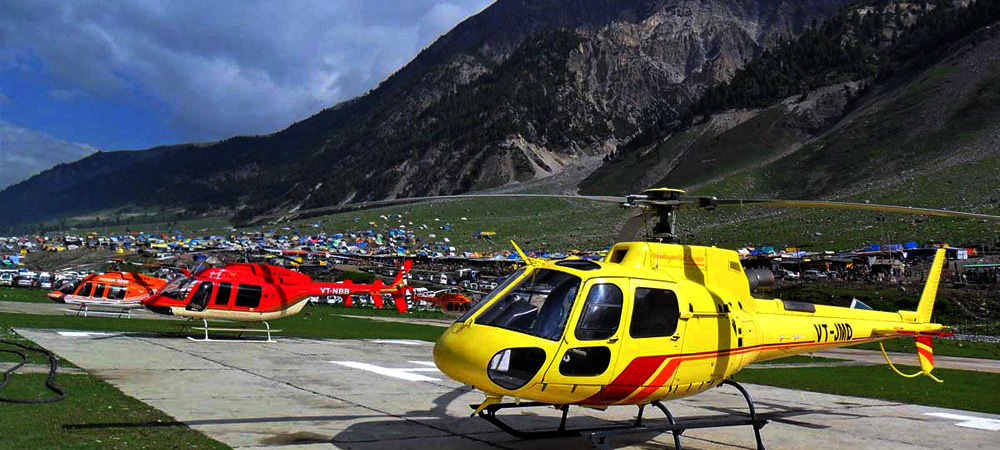Amarnath Temple is a Hindu shrine located in Anantnag district of Jammu and Kashmir, India. A cave situated at an altitude of 3,888 m (12,756 ft),[1] about 168 km from Anantnag city, the district headquarters, 141 km (88 mi) from Srinagar, the summer capital of Jammu and Kashmir, reached through Pahalgam town. The shrine represents an important part of Hinduism.[2][3] The cave, located in Lidder Valley, is surrounded by glaciers, snowy mountains and is covered with snow most of the year, except for a short period in the summer, when it is open to pilgrims. In 1989, pilgrims numbered between 12,000 and 30,000. In 2011, the numbers reached a peak, crossing 6.3 lakh (630,000) pilgrims. In 2018 pilgrims numbered 2.85 lakh (285,000). The annual pilgrimage has varied between 20 and 60 days.
The Amarnath cave, abode of the Mahamaya Shakti Peetha, is one of the 51 Shakti Peethas, temples on the Indian Subcontinent that commemorate the location of fallen body parts of the Hindu deity Sati.[4]
Shiva Linga
Further information: Lingam
Ice Lingam of Lord Shiva at the Amarnath Cave Temple
The Shiva Lingam at the shrine is a Swayambhu lingam. The lingam is a natural stalagmite formation inside a 40 m (130 ft) tall cave at an elevation of 3,888 m (12,756 ft) on the Amarnath Mountain, which has a peak of 5,186 metres (17,014 ft). The stalagmite is formed due to the freezing of water drops that fall from the roof of the cave onto the floor, resulting in an upward growth of an ice formation. Here, the stalagmites considered as the lingam, a physical manifestation of Shiva, form a solid-dome-shape. Two smaller stalagmites are thought to represent Parvati and Ganesha.[5]
According to the ancient Hindu texts of the Mahabharata and Puranas a lingam represents Shiva.[6] The lingam waxes during May to August, as snow melts in the Himalayas above the cave, and water seeps into the rocks of the cave; thereafter, the lingam gradually wanes.[1][unreliable source?] Religious beliefs hold that the lingam grows and shrinks with the phases of the moon, reaching its height during the summer festival.[7][unreliable source?] Hindus believe this is the place where Shiva explained the secret of life and eternity to his divine consort, Parvati.[8][9]
Lidder Valley, where the cave is located, has a number of glaciers.[10] In 2009, glaciologist M. N. Koul, the former head of the geography department at the University of Jammu, has said that while more scientific studies are needed, contributors to change in lingam size could include changes in the water’s pathways to the lingum.[10] The cave is made of limestone and gypsum.[11] Heat generated by tourists affects the size of the stalagmite.[11] Outside temperate changes also affect their size.[12][13] To minimize artificially induced temperature changes, helicopter trips and helipad sites are regulated.[10] There has been talk of artificially extending the life of the stalagmites, this has met with objections.[10][11]
History
Ancient history
Part of a series on
Hinduism
1 Om.svg
HindusHistoryTimeline
Origins
Traditions
Deities
Concepts
Practices
Philosophical schools
Gurus, sants, philosophers
Texts
Society
Other topics
GlossaryOutline
Hinduism portal
vte
The book Rajatarangini (Book VII v. 183) refers to Krishaanth or Amarnath. It is believed that in the 11th century CE, Queen Suryamati gifted trishulas, banalingas and other sacred emblems to this temple.[14] Rajavalipataka, begun by Prajna Bhatta, contains detailed references to the pilgrimage to Amarnath Cave Temple. In addition, there are further references to this pilgrimage in many other ancient texts.
Medieval history
Painting of devotees in the Amarnath cave temple. Jammu, Pahari, circa mid-19th century
François Bernier, a French physician, accompanied Emperor Aurangzeb during his visit to Kashmir in 1663. In his book Travels in Mughal Empire, he provides an account of the places he visited, noting that he was “pursuing journey to a grotto full of wonderful congelations, two days journey from Sangsafed” when he “received intelligence that my Nawab felt very impatient and uneasy on account of my long absence.” The “grotto” referenced in this passage is obviously the Amarnath cave — as the editor of the second edition of the English translation of the book, Vincent A. Smith, makes clear in his introduction. He writes: “The grotto full of wonderful congelations is the Amarnath cave, where blocks of ice, stalagmites formed by dripping water from the roof are worshipped by many Hindus who resort here as images of Shiva



